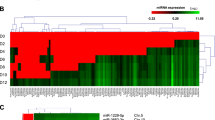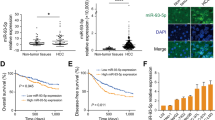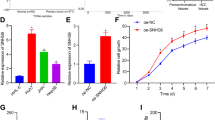Abstract
The human genome is replete with long non-coding RNAs (lncRNA), many of which are transcribed and likely to have a functional role. Microarray analysis of >23 000 lncRNAs revealed downregulation of 712 (∼3%) lncRNA in malignant hepatocytes, among which maternally expressed gene 3 (MEG3) was downregulated by 210-fold relative to expression in non-malignant hepatocytes. MEG3 expression was markedly reduced in four human hepatocellular cancer (HCC) cell lines compared with normal hepatocytes by real-time PCR. RNA in situ hybridization showed intense cytoplasmic expression of MEG3 in non-neoplastic liver with absent or very weak expression in HCC tissues. Enforced expression of MEG3 in HCC cells significantly decreased both anchorage-dependent and -independent cell growth, and induced apoptosis. MEG3 promoter hypermethylation was identified by methylation-specific PCR and MEG3 expression was increased with inhibition of methylation with either 5-Aza-2-Deoxycytidine, or siRNA to DNA Methyltransferase (DNMT) 1 and 3b in HCC cells. MiRNA-dependent regulation of MEG3 expression was studied by evaluating the involvement of miR-29, which can modulate DNMT 1 and 3. Overexpression of mir-29a increased expression of MEG3. GTL2, the murine homolog of MEG3, was reduced in liver tissues from hepatocyte-specific miR-29a/b1 knock-out mice compared with wild-type controls. These data show that methylation-dependent tissue-specific regulation of the lncRNA MEG3 by miR-29a may contribute to HCC growth and highlight the inter-relationship between two classes of non-coding RNA, miRNAs and lncRNAs, and epigenetic regulation of gene expression.
This is a preview of subscription content, access via your institution
Access options
Subscribe to this journal
Receive 50 print issues and online access
$259.00 per year
only $5.18 per issue
Buy this article
- Purchase on Springer Link
- Instant access to full article PDF
Prices may be subject to local taxes which are calculated during checkout




Similar content being viewed by others
References
Benetatos L, Dasoula A, Hatzimichael E, Georgiou I, Syrrou M, Bourantas KL . (2008). Promoter hypermethylation of the MEG3 (DLK1/MEG3) imprinted gene in multiple myeloma. Clin Lymphoma Myeloma 8: 171–175.
Benetatos L, Hatzimichael E, Dasoula A, Dranitsaris G, Tsiara S, Syrrou M et al. (2010). CpG methylation analysis of the MEG3 and SNRPN imprinted genes in acute myeloid leukemia and myelodysplastic syndromes. Leuk Res 34: 148–153.
Braconi C, Valeri N, Gasparini P, Huang N, Taccioli C, Nuovo G et al. (2010). Hepatitis C virus proteins modulate microRNA expression and chemosensitivity in malignant hepatocytes. Clin Cancer Res 16: 957–966.
Braconi C, Valeri N, Kogure T, Gasparini P, Huang N, Nuovo GJ et al. (2011). Expression and functional role of a transcribed noncoding RNA with an ultraconserved element in hepatocellular carcinoma. Proc Natl Acad Sci USA 108: 786–791.
Bressac B, Galvin KM, Liang TJ, Isselbacher KJ, Wands JR, Ozturk M . (1990). Abnormal structure and expression of p53 gene in human hepatocellular carcinoma. Proc Natl Acad Sci USA 87: 1973–1977.
Cazals-Hatem D, Rebouissou S, Bioulac-Sage P, Bluteau O, Blanche H, Franco D et al. (2004). Clinical and molecular analysis of combined hepatocellular-cholangiocarcinomas. J Hepatol 41: 292–298.
Coulouarn C, Factor VM, Andersen JB, Durkin ME, Thorgeirsson SS . (2009). Loss of miR-122 expression in liver cancer correlates with suppression of the hepatic phenotype and gain of metastatic properties. Oncogene 28: 3526–3536.
Croce CM . (2009). Causes and consequences of microRNA dysregulation in cancer. Nat Rev Genet 10: 704–714.
Fabbri M, Garzon R, Cimmino A, Liu Z, Zanesi N, Callegari E et al. (2007). MicroRNA-29 family reverts aberrant methylation in lung cancer by targeting DNA methyltransferases 3A and 3B. Proc Natl Acad Sci USA 104: 15805–15810.
Garzon R, Liu S, Fabbri M, Liu Z, Heaphy CE, Callegari E et al. (2009). MicroRNA-29b induces global DNA hypomethylation and tumor suppressor gene reexpression in acute myeloid leukemia by targeting directly DNMT3A and 3B and indirectly DNMT1. Blood 113: 6411–6418.
Gramantieri L, Fornari F, Ferracin M, Veronese A, Sabbioni S, Calin GA et al. (2009). MicroRNA-221 targets Bmf in hepatocellular carcinoma and correlates with tumor multifocality. Clin Cancer Res 15: 5073–5081.
Hagan JP, O'Neill BL, Stewart CL, Kozlov SV, Croce CM . (2009). At least ten genes define the imprinted Dlk1-Dio3 cluster on mouse chromosome 12qF1. PLoS One 4: e4352.
Huarte M, Rinn JL . (2010). Large non-coding RNAs: missing links in cancer? Hum Mol Genet 19: R152–R161.
Kawaji H, Severin J, Lizio M, Forrest AR, van NE, Rehli M et al. (2011). Update of the FANTOM web resource: from mammalian transcriptional landscape to its dynamic regulation. Nucleic Acids Res 39: D856–D860.
Ji J, Shi J, Budhu A, Yu Z, Forgues M, Roessler S et al. (2009). MicroRNA expression, survival, and response to interferon in liver cancer. N Engl J Med 361: 1437–1447.
Louro R, Smirnova AS, Verjovski-Almeida S . (2009). Long intronic noncoding RNA transcription: expression noise or expression choice? Genomics 93: 291–298.
Lujambio A, Ropero S, Ballestar E, Fraga MF, Cerrato C, Seti F et al. (2007). Genetic unmasking of an epigenetically silenced microRNA in human cancer cells. Cancer Res 67: 1424–1429.
Lujambio A, Calin GA, Villanueva A, Ropero S, Sanchez-Caspedes M, Blanco D et al. (2008). A microRNA DNA methylation signature for human cancer metastasis. Proc Natl Acad Sci USA 105: 13556–13561.
Lujambio A, Portela A, Liz J, Melo SA, Rossi S, Spizzo R et al. (2010). CpG island hypermethylation-associated silencing of non-coding RNAs transcribed from ultraconserved regions in human cancer. Oncogene 29: 6390–6401.
Matouk IJ, Degroot N, Mezan S, Ayesh S, bu-Lail R, Hochberg A et al. (2007). The H19 non-coding RNA is essential for human tumor growth. PLoS One 2: e845.
Meng F, Henson R, Wehbe-Janek H, Ghoshal K, Jacob ST, Patel T . (2007). MicroRNA-21 regulates expression of the PTEN tumor suppressor gene in human hepatocellular cancer. Gastroenterology 133: 647–658.
Mercer TR, Dinger ME, Mattick JS . (2009). Long non-coding RNAs: insights into functions. Nat Rev Genet 10: 155–159.
Oliva J, Bardag-Gorce F, French BA, Li J, French SW . (2009). The regulation of non-coding RNA expression in the liver of mice fed DDC. Exp Mol Pathol 87: 12–19.
Orom UA, Derrien T, Beringer M, Gumireddy K, Gardini A, Bussotti G et al. (2010). Long noncoding RNAs with enhancer-like function in human cells. Cell 143: 46–58.
Panzitt K, Tschernatsch MM, Guelly C, Moustafa T, Stradner M, Strohmaier HM et al. (2007). Characterization of HULC, a novel gene with striking up-regulation in hepatocellular carcinoma, as noncoding RNA. Gastroenterology 132: 330–342.
Pineau P, Volinia S, McJunkin K, Marchio A, Battiston C, Terris B et al. (2010). miR-221 overexpression contributes to liver tumorigenesis. Proc Natl Acad Sci USA 107: 264–269.
Saito Y, Liang G, Egger G, Friedman JM, Chuang JC, Coetzee GA et al. (2010). Specific activation of microRNA-127 with downregulation of the proto-oncogene BCL6 by chromatin-modifying drugs in human cancer cells. Cancer Cell 9: 435–443.
Su H, Yang JR, Xu T, Huang J, Xu L, Yuan Y et al. (2009). MicroRNA-101, down-regulated in hepatocellular carcinoma, promotes apoptosis and suppresses tumorigenicity. Cancer Res 69: 1135–1142.
Wang B, Majumder S, Nuovo G, Kutay H, Volinia S, Patel T et al. (2009). Role of microRNA-155 at early stages of hepatocarcinogenesis induced by choline-deficient and amino acid-defined diet in C57BL/6 mice. Hepatology 50: 1152–1161.
Wojcik SE, Rossi S, Shimizu M, Nicoloso MS, Cimmino A, Alder H et al. (2010). Non-codingRNA sequence variations in human chronic lymphocytic leukemia and colorectal cancer. Carcinogenesis 31: 208–215.
Xiong Y, Fang JH, Yun JP, Yang J, Zhang Y, Jia WH et al. (2010). Effects of microRNA-29 on apoptosis, tumorigenicity, and prognosis of hepatocellular carcinoma. Hepatology 51: 836–845.
Zhang X, Gejman R, Mahta A, Zhong Y, Rice KA, Zhou Y et al. (2010a). Maternally expressed gene 3, an imprinted noncoding RNA gene, is associated with meningioma pathogenesis and progression. Cancer Res 70: 2350–2358.
Zhang X, Rice K, Wang Y, Chen W, Zhong Y, Nakayama Y et al. (2010b). Maternally expressed gene 3 (MEG3) noncoding ribonucleic acid: isoform structure, expression, and functions. Endocrinology 151: 939–947.
Zhang X, Zhou Y, Mehta KR, Danila DC, Scolavino S, Johnson SR et al. (2003). A pituitary-derived MEG3 isoform functions as a growth suppressor in tumor cells. J Clin Endocrinol Metab 88: 5119–5126.
Zhao J, Dahle D, Zhou Y, Zhang X, Klibanski A . (2005). Hypermethylation of the promoter region is associated with the loss of MEG3 gene expression in human pituitary tumors. J Clin Endocrinol Metab 90: 2179–2186.
Zhou Y, Zhong Y, Wang Y, Zhang X, Batista DL, Gejman R et al. (2007). Activation of p53 by MEG3 non-coding RNA. J Biol Chem 282: 24731–24742.
Author information
Authors and Affiliations
Corresponding author
Ethics declarations
Competing interests
The authors declare no conflict of interest.
Additional information
Supplementary Information accompanies the paper on the Oncogene website
Rights and permissions
About this article
Cite this article
Braconi, C., Kogure, T., Valeri, N. et al. microRNA-29 can regulate expression of the long non-coding RNA gene MEG3 in hepatocellular cancer. Oncogene 30, 4750–4756 (2011). https://doi.org/10.1038/onc.2011.193
Received:
Revised:
Accepted:
Published:
Issue Date:
DOI: https://doi.org/10.1038/onc.2011.193
Keywords
This article is cited by
-
The role of miRNA-29b1, MMP-2, MMP-9 mRNAs, and proteins in early diagnosis of HCC
Egyptian Journal of Medical Human Genetics (2023)
-
Differential expression profile and in-silico functional analysis of long noncoding RNA and mRNA in duck embryo fibroblasts infected with duck plague virus
BMC Genomics (2022)
-
LncRNA MEG3 promotes cisplatin sensitivity of cervical cancer cells by regulating the miR-21/PTEN axis
BMC Cancer (2022)
-
CircSCAP interacts with SF3A3 to inhibit the malignance of non-small cell lung cancer by activating p53 signaling
Journal of Experimental & Clinical Cancer Research (2022)
-
LncRNA SEMA3B-AS1 inhibits breast cancer progression by targeting miR-3940/KLLN axis
Cell Death & Disease (2022)



